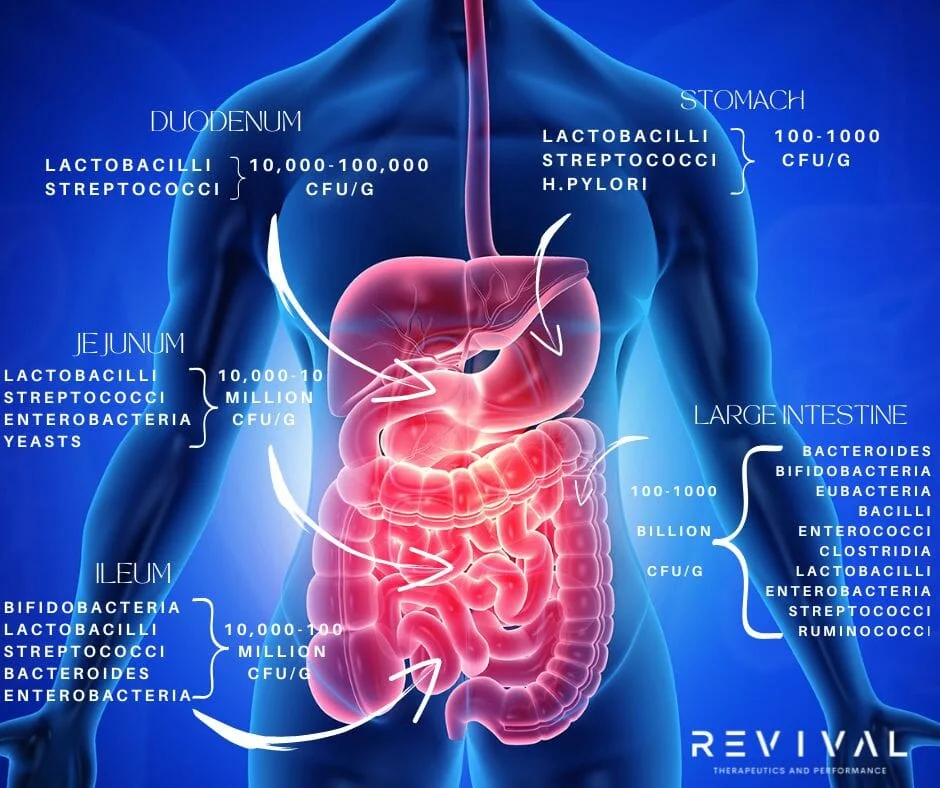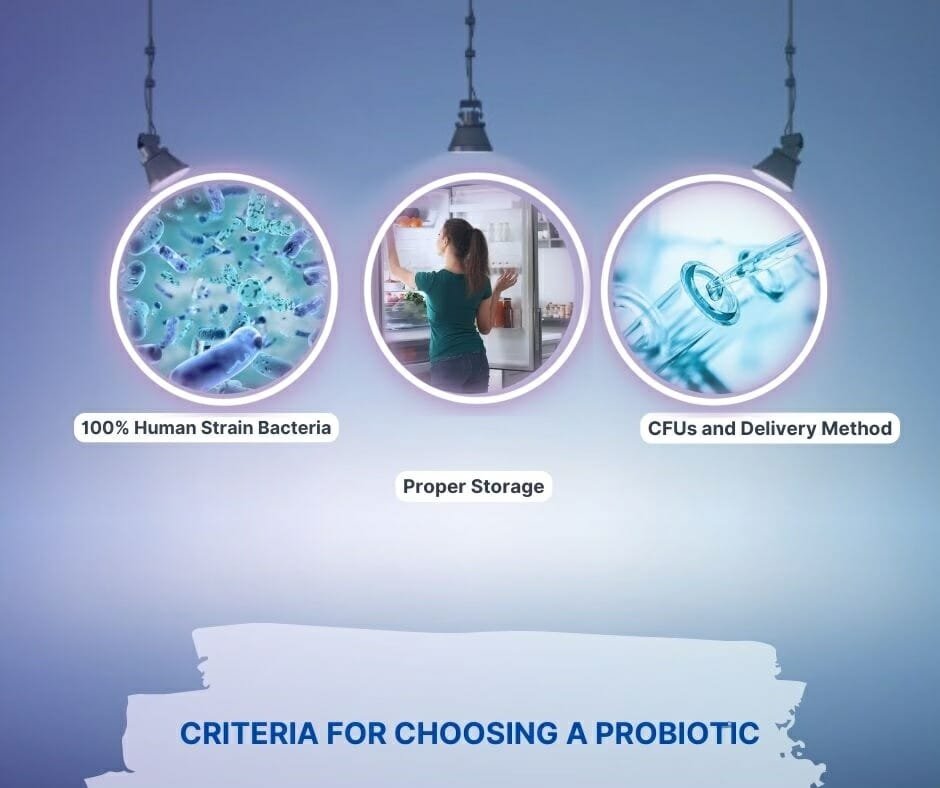
Are you familiar with the gut feeling that something is off? Research has established that our digestive systems play a crucial role in managing disease and promoting overall health and well-being. A substantial portion of the immune system (approximately 80%) is located in the gut, highlighting the critical role of gastrointestinal health in immune function (3).
Our microbiomes, which contain over 100,000 billion microbes, can be easily impacted by poor diets, medication, lifestyle habits, and disease (9). This can lead to a reduction in good bacteria and the onset of various conditions like bloating, constipation, diarrhea, pain, food intolerances, immune system suppression and inflammation.
That’s where probiotics come in. Probiotics contain friendly bacteria and are one of the most researched ways to replenish the microbiome (13). However, not all probiotics are created equal. Choosing the right probiotic requires evaluating several criteria, such as selecting the appropriate species and strain and choosing the right potency and delivery method.
WHEN LOOKING FOR A PROBIOTIC, IT IS IMPORTANT TO CONSIDER THE FOLLOWING CRITERIA:
- Selecting the appropriate species and strain
Choosing the appropriate species and strain (example: Lactobacillus acidophilus is the species and CUL-60 is the strain) is crucial (5). Although there are a lot of options available, it is important to note that a lot of grocery and drug store probiotics contain non-human-derived strains of lactobacilli and bifidobacteria. These cannot colonize the gut and are excreted quickly after consumption(7)(4). Although these probiotics may initially appear cheaper compared to human-derived strains, most of the time these types do not contribute to long-term benefits and are not worth the cost.
When looking at overall probiotic research, it has been shown that human-derived strain probiotics are superior to just about any other form of probiotic because the human strain bacteria can adhere and colonize the gut much more effectively as compared to other non-human strains (1). They are also highly tolerant to stomach acid so when the probiotic capsule is ingested, it can withstand passage through the stomach to effectively colonize in the small intestine (1).
There are 4 particular human-derived strains and species that have been broadly studied, Lactobacillus acidophilus (CUL-60), Lactobacillus acidophilus(CUL-21), Bifidobacterium bifidum(CUL-20)and Bifidobacterium animalis subsp.lactis(CUL- 34). Broadly speaking, the Lactobacillus Acidophilus species helps with diarrhea from antibiotics, irritable bowel syndrome (IBS), helps to prevent vaginal infections in women and can boost immunity (2). The Bifidobacterium bifidum species has been shown to help with IBS symptoms and to prevent common colds (10). Bifidobacterium animalis subsp. lactis is helpful in lowering the frequency of infant colic, reducing constipation and other IBS systems and also preventing upper respiratory tract infections (11).
- Choosing the right potency and delivery method
Choosing the right species and strain is only part of the requirements when picking a probiotic that your body will actually absorb and utilize. The potency and delivery method also matter.
Colony forming units (CFUs) are usually listed on a probiotic supplement and it refers to the dose of live, viable, probiotic bacteria that the supplement contains. However, having the right amount of CFUs is not enough as effectiveness is best determined through the intestinal tract carriage. When taking a probiotic, the right delivery method needs to be taken into account since bacteria colonize in varying concentrations throughout the gastrointestinal tract (8).
Before starting a probiotic supplement, it is recommended to consult with a healthcare provider to determine the appropriate colony-forming units necessary for a specific condition.
Looking at the inserted image, we can see different species colonizing the different areas in the gastrointestinal tract.

- Storage and expiration
Proper storage and handling of probiotics is crucial to ensure their effectiveness. It is recommended to keep probiotics refrigerated to maintain their potency and avoid exposure to heat which can cause the death of microorganisms in the supplement (6). An alternative is to purchase a probiotic that indicates it is shelf stable and does not require refrigeration. Be sure to purchase probiotics from a reputable source that stores them properly.
It is also important to check the expiration date on the label as the number of colony-forming units (CFUs) in probiotics can decline over time, making them less effective (12).
WHAT ARE EXAMPLES OF A GOOD PROBIOTIC?

One probiotic supplement that meets these criteria is HMF Forte, which contains 20 billion CFUs of the four human-derived strains mentioned above per daily dose. This is available as both refrigerated and shelf stable. For those with more specific needs, HMF Intensive and HMF IBS Relief, both contain 25 billion CFUs of the four human-derived strains.
It is important to always take probiotics with a meal and to wait 2-3 hours before or after taking antibiotics. If you have to take antibiotics, it is important to talk to your doctor about incorporating probiotics during your antibiotic period and especially after.
With so many stressors in our daily lives affecting our microbiome, a high-quality probiotic can be an effective way to replenish the good bacteria and support our digestive health. By considering the appropriate species and strain, potency, and delivery method, you can make an informed choice about the probiotic supplement that’s right for you.
Disclaimer:
This article does not constitute as medication advice. Supplementation and manual therapy should not be considered as a substitute for traditional medical care and it is always recommended to consult with a healthcare professional before making any changes, especially if you have any underlying health conditions or are taking any medications.
References:
- Ahmed, Sohail & Marchesi, Julian R. “Human-derived Probiotics: An Overview” Frontiers in Microbiology, 2020
- Bull M, Plummer S, Marchesi J, Mahenthiralingam E. The life history of Lactobacillus acidophilus as a probiotic: a tale of revisionary taxonomy, misidentification and commercial success. FEMS Microbiol Lett. 2013 Dec;349(2):77-87.
- Kau, A. L., Ahern, P. P., Griffin, N. W., Goodman, A. L., & Gordon, J. I. (2011). Human nutrition, the gut microbiome, and the immune system: envisioning the future. Nature, 474(7351), 327-336.
- Laffin, M. R., & Fedorak, R. N. (2020). Human origin probiotics: are they more effective than their non-human counterparts? Canadian Journal of Gastroenterology and Hepatology
- Marchesi JR, Adams DH, Fava F, Hermes GD, Hirschfield GM, Hold G, Quraishi MN, Kinross J, Smidt H, Tuohy KM, Thomas LV, Zoetendal EG, Hart A. The gut microbiota and host health: a new clinical frontier. Gut. 2016 Feb;65(2):330-9.
- Ouwehand, A. C., ten Bruggencate, S. J. M., Schonewille, A. J., Alhoniemi, E., & Forssten, S. D. (2016). Effectiveness of probiotics on the duration of illness in healthy children and adults who develop common acute respiratory infectious conditions: a systematic review and meta-analysis. British Journal of Nutrition, 116(4), 733-741.
- Saxelin M, Lassig A, Karjalainen H, Tynkkynen S, Surakka A, Vapaatalo H, Järvenpää S, Korpela R, Mutanen M, Hatakka K. Persistence of probiotic strains in the gastrointestinal tract when administered as capsules, yoghurt, or cheese. Int J Food Microbiol. 2010 Oct 15;144(2):293-300.
- Šipailienė A, Petraitytė S. Encapsulation of Probiotics: Proper Selection of the Probiotic Strain and the Influence of Encapsulation Technology and Materials on the Viability of Encapsulated Microorganisms. Probiotics Antimicrob Proteins. 2018 Mar;10(1):1-10
- Tsai YL, Lin TL, Chang CJ, Wu TR, Lai WF, Lu CC, Lai HC. Probiotics, prebiotics and amelioration of diseases. J Biomed Sci. 2019 Jan 4;26(1):3.
- Turroni F, Duranti S, Milani C, Lugli GA, van Sinderen D, Ventura M. Bifidobacterium bifidum: A Key Member of the Early Human Gut Microbiota. Microorganisms. 2019 Nov 9;7(11):544
- Uusitupa HM, Rasinkangas P, Lehtinen MJ, Mäkelä SM, Airaksinen K, Anglenius H, Ouwehand AC, Maukonen J. Bifidobacterium animalis subsp. lactis 420 for Metabolic Health: Review of the Research. Nutrients. 2020 Mar 25;12(4):892.
- West, N. P., Horn, P. L., Pyne, D. B., Gebski, V. J., Lahtinen, S. J., Fricker, P. A., & Cripps, A. W. (2014). Probiotic supplementation for respiratory and gastrointestinal illness symptoms in healthy physically active individuals. Clinical Nutrition, 33(4), 581-587.
- Yadav MK, Kumari I, Singh B, Sharma KK, Tiwari SK. Probiotics, prebiotics and synbiotics: Safe options for next-generation therapeutics. Appl Microbiol Biotechnol. 2022 Jan;106(2):505-521

